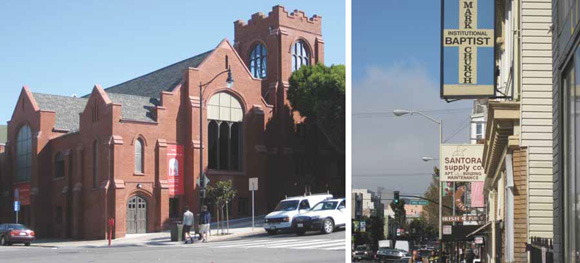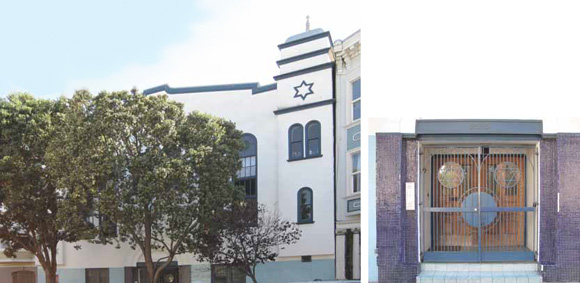
I doubt I am alone in thinking of San Francisco as a food Mecca rather than a spiritual one. When I exit my apartment onto busy 18th Street in the Mission District, there is Tartine Bakery with its wafting smells of caramelized sugar and butter amidst the Victorian apartment buildings. Crowds gather outside the deceptively modest storefronts of Delfina Restaurant and its adjacent pizzeria; and the line of people waiting to order ice cream wraps around the corner from Bi-Rite Creamery.
Just two blocks from this hub of food idolatry is the Mission Dolores, one of the missions established by the Spanish in the eighteenth century and the oldest building in San Francisco. Despite the Mission District being named after this Mission, I had never paid much attention to it or any other religious buildings or spiritual centers here. Even after living in this neighborhood for nine years, it took a return to the Mission after a three-year stint back on the East Coast for me to see it in a new light. Used to church spires piercing the New England landscape, what struck me when I returned to San Francisco were the number and variety of buildings devoted to religion and spirituality in my neighborhood.
On my frequent walks in the Mission, I began to look for these sacred spaces and spotted at least one on nearly every block. While some of these sacred buildings are obvious—commanding a large piece of real estate or with familiar details (a steeple, a rose window, a dome)—many are more modest in size and without these familiar markers: a modest, two-story building in a row of Victorians; a one-story building, looking like a former mechanic’s garage, marked with a simple cross at its peak; a meditation center nestled on a side street next to a cleaning supply store. Or the normally inconspicuous storefront that comes alive with gospel music on weekday nights, its door flung open and the music of tambourine and electric guitar pouring forth.
In taking an informal survey of these sacred spaces in the Mission, a couple of notable themes emerged; the first is contrast. The Mission District is truly a “mixed use” district, and the sacred often stands side-by-side with the mundane or the profane. Second is the theme of transformation. There are many examples of buildings being transformed from sacred to common uses or from one religion to another. This article begins to explore these themes.
Contrast
The modern San Francisco we know has its origins in both the sacred and the profane: a half century after the founding of the Mission Dolores, gold mania rushed in, bringing along with it saloons and establishments of “ill-repute,” thus creating the so-called Barbary Coast. This contrast between the sacred and the profane, or at the very least mundane, continues to be evident today.
Walking two blocks east on 16th Street from the Mission Dolores, I hit Valencia Street, one of the main commercial streets of this District, hosting a parade of all types and ages of people. Just shy of two miles long, Valencia has restaurants of all scales and sorts, cafes, bars, clothing stores, boutiques, galleries, workspaces, locally owned bookstores, and bike shops. Interspersed among these businesses is a cross-section of religious buildings.
For example, commanding most of a city block near 14th Street is the Greek Orthodox Cathedral of the Annunciation. Clad in light stucco and reminiscent of Byzantine monuments, this grand complex includes an educational facility and auditorium. The congregation is on the verge of expanding the complex to include a domed chapel modeled on the Hagia Sophia. In contrast, just a half-block from the Cathedral, and within view of it, is an imposing brick Moorish castle. Equally grand as the Cathedral, this castle is the former Mission Armory and home, since 2007, to the adult bondage website kink.com.
Some contrasts are more subtle: farther down Valencia is the unadorned building of St. Mark Institutional Baptist Church, which neighbors the storefront for Santora Cleaning Supplies and is just yards away from an Irish pub in one direction and a neighborhood bar in the other. Santora Supplies may have an affinity for the sacred, because a second Santora store is located just a few blocks away off Valencia on the side street Bartlett, next to the San Francisco Buddhist Center.
These are just a few examples; while most may not present as extreme a contrast as the Annunciation Cathedral and the kink.com Armory, it became clear to me that an important component of the energy of the Mission is the presence of the various congregations and their sacred spaces intermixed with the bars and restaurants. Perhaps it is because these sacred spaces balance the other “temples” of hedonism.
Transformation
San Francisco is a place of transformation for many people, a welcome place to shift identities. The same can be said for its sacred spaces: congregations shift, religious buildings become obsolete, and new assemblies emerge.
Nationally, there is a recurring issue with traditionally religious buildings being underused because of dwindling congregations and mounting maintenance expenses. At the crossroads of tradition, meaning, and form, these buildings often are the “white elephants” that present issues with redeveloping them for other purposes. But many communities still work to save these buildings because of their symbolism and uniqueness.

In my immediate neighborhood, there are examples of some of these religious buildings in various stages of transition. On 19th Street, the former B’nai David Temple became apartments in 1981. Situated mid-block and partially shrouded by trees, a quick glance may not find its earlier incarnation, but the building still bears clear markers of its earlier life: Stars of David in its windows and the front gate, as well as a bas relief of the Torah above the main entry.
A couple of blocks away, also on 19th Street and overlooking Dolores Park, is the currently dubbed “Castle on the Park.” This gothic revival castle is the former Golden Gate Lutheran Church (called Norwegian Lutheran Church prior to 1970), which was deconsecrated in 2005. After the church ceased operations due to a shrinking membership and delayed maintenance, a private developer transformed it into a massive single family home, which, as of October 2010, was still on the market for just shy of $7.5 million.
A far more humble example of the transition from sacred space to mundane is the former Methodist Church at Guerrero and Camp Streets, which is currently residential. The developer is retaining the rose window and large gothic windows, symbols of its previous incarnation.

Not all transformations are from the sacred to the mundane. Some are the reverse, or even from one sacred use to another. A dramatic example of this in the Mission is that of the former St. John’s Evangelical Lutheran Church into the current Hua Zang Si Buddhist Temple. Built at the turn of the twentieth century for a mostly German congregation, this gothic revival church retains the structure indicating its previous affiliation—e.g., spire and gothic windows—but has been transformed with a dramatic paint job and additional features, like the Chinese-style doors and Chinese characters.
As a place of diverse individuals, the diversity of forms of San Francisco’s sacred spaces should come as no surprise. Together, these spaces provide insights into the Mission’s diversity of beliefs and shifting neighborhood demographics, and remind us of the sacred surrounding us.
Author Sara K. Hayden, Esq., is an attorney with Watt, Tieder, Hoffar & Fitzgerald in San Francisco.
Originally published 4th quarter 2010, in arcCA 10.4, “Faith & Loss.”






